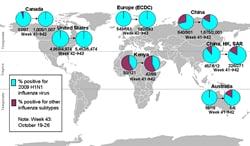You are subscribed to updates from the Centers for Disease Control and Prevention (CDC).
Sign up for the CDC H1N1 Flu Mobile Texting Pilot
 In case you missed it, it’s not too late to sign up! Become a part of the H1N1 Flu Mobile Texting Pilot and have important CDC information about H1N1 flu and other topics
delivered directly to your mobile phone.
In case you missed it, it’s not too late to sign up! Become a part of the H1N1 Flu Mobile Texting Pilot and have important CDC information about H1N1 flu and other topics
delivered directly to your mobile phone.
In September 2009, CDC launched a three-month text messaging campaign pilot to share important, timely health information directly to users. To subscribe to the pilot, text HEALTH to 87000. Subscribers can expect to receive about three health messages a week during the three-month pilot. Standard text messaging rates will apply. For more information about the pilot, visit http://www.cdc.gov/mobile.
Key Flu Indicators
Each week CDC analyzes information about influenza disease activity in the United States and publishes findings of key flu indicators in a report called FluView. During the week of October 18-24, 2009, a review of the key indicators found that influenza activity continued to increase in the United States from the previous week. Below is a summary of the most recent key indicators:
- Visits to doctors for influenza-like illness (ILI) increased steeply since last week in the United States, and overall, are much higher than what is expected for this time of the year. ILI activity now is higher than what is seen during the peak of many regular flu seasons.
- Total influenza hospitalization rates for laboratory-confirmed flu are climbing and are higher than expected for this time of year. Hospitalization rates continue to be highest is younger populations with the highest hospitalization rate reported in children 0-4 years old.
- The proportion of deaths attributed to pneumonia and influenza (P&I) based on the 122 Cities Report has increased and has been higher than what is expected at this time of year for four weeks now. In addition, 22 flu-related pediatric deaths were reported this week; 19 of these deaths were confirmed 2009 H1N1, and three were influenza A viruses, but were not subtyped. Since April 2009, CDC has received reports of 114 laboratory-confirmed pediatric 2009 H1N1 deaths and another 12 pediatric deaths that were laboratory confirmed as influenza, but where the flu virus subtype was not determined.
- Forty-eight states are reporting widespread influenza activity at this time. They are: Alabama, Alaska, Arizona, Arkansas, California, Colorado, Connecticut, Delaware, Florida, Georgia, Idaho, Illinois, Indiana, Iowa, Kansas, Kentucky, Louisiana, Maine, Maryland, Massachusetts, Michigan, Minnesota, Mississippi, Missouri, Montana, Nebraska, Nevada, New Hampshire, New Jersey, New Mexico, New York, North Carolina, North Dakota, Ohio, Oklahoma, Oregon, Pennsylvania, Rhode Island, South Dakota, Tennessee, Texas, Utah, Vermont, Virginia, Washington, West Virginia, Wisconsin, and Wyoming. This many reports of widespread activity are unprecedented during seasonal flu.
- Almost all of the influenza viruses identified so far are 2009 H1N1 influenza A viruses. These viruses remain similar to the virus chosen for the 2009 H1N1 vaccine, and remain susceptible to the antiviral drugs oseltamivir and zanamivir with rare exception.
U.S. Situation Update
U.S. Patient Visits Reported for Influenza-like Illness (ILI)

U.S. Influenza-like Illness (ILI) Reported by Regions

|
Cases Defined by
|
Hospitalizations
|
Deaths
|
|
|---|---|---|---|
| Influenza and Pneumonia Syndrome* | 25,985 | 2,916 | |
| Influenza Laboratory-Tests** | 12,466 | 530 | |
|
*Reports can be based on syndromic, admission or discharge data, or a combination of data elements that could include laboratory-confirmed and influenza-like illness hospitalizations. **Laboratory confirmation includes any positive influenza test (rapid influenza tests, RT-PCR, DFA, IFA, or culture), whether or not typing was done. This table is based on data reported to CDC by U.S. states and territories from a new influenza and pneumonia hospitalizations and deaths web-based reporting system. This system will be used to monitor trends in activity for the 2009-10 influenza season. This is a cumulative count beginning August 30, 2009. The table shows aggregate reports of all influenza and pneumonia-associated hospitalizations and deaths (including 2009 H1N1 and seasonal flu) since August 30, 2009 received by CDC from U.S. states and territories. This table will be updated weekly each Friday at 11 a.m. For the 2009-2010 influenza season, states are reporting based on new case definitions for hospitalizations and deaths effective August 30, 2009. CDC will continue to use its traditional surveillance systems to track the progress of the 2009-2010 influenza season. For more information about influenza surveillance, including reporting of influenza-associated hospitalizations and deaths, see Questions and Answers: Monitoring Influenza Activity, Including 2009 H1N1. The number of 2009 H1N1 hospitalizations and deaths reported to CDC from April – August 2009 is available on the Past Situation Updates page. For state level information, refer to state health departments. International Human Cases of 2009 H1N1 Flu Infection
|
|||
For more information about the U.S. situation, see the CDC H1N1 Flu U.S. Situation page.
International Situation Update
 This report provides an update to the international situation as of October 30, 2009. The World Health Organization (WHO) continues to report laboratory-confirmed 2009 H1N1 flu cases and deaths on its Web page. These laboratory-confirmed cases represent a substantial underestimation of total cases in the world, as many countries
focus surveillance and laboratory testing only on people with severe illness. The 2009 H1N1 influenza virus continues to be the dominant influenza virus in circulation in the world. Since April 19, 2009, over half of all influenza positive specimens reported to WHO were 2009 H1N1. In temperate regions of the Southern Hemisphere, little disease due to 2009 H1N1 has been reported. In tropical regions of the Americas and Asia, influenza activity due to 2009 H1N1 remains variable. In temperate
regions of the Northern Hemisphere, high rates of influenza-like illness (ILI) activity due to 2009 H1N1 have been reported in many areas, including parts of Western Europe, most of the United States, and parts of Mexico and Canada.
This report provides an update to the international situation as of October 30, 2009. The World Health Organization (WHO) continues to report laboratory-confirmed 2009 H1N1 flu cases and deaths on its Web page. These laboratory-confirmed cases represent a substantial underestimation of total cases in the world, as many countries
focus surveillance and laboratory testing only on people with severe illness. The 2009 H1N1 influenza virus continues to be the dominant influenza virus in circulation in the world. Since April 19, 2009, over half of all influenza positive specimens reported to WHO were 2009 H1N1. In temperate regions of the Southern Hemisphere, little disease due to 2009 H1N1 has been reported. In tropical regions of the Americas and Asia, influenza activity due to 2009 H1N1 remains variable. In temperate
regions of the Northern Hemisphere, high rates of influenza-like illness (ILI) activity due to 2009 H1N1 have been reported in many areas, including parts of Western Europe, most of the United States, and parts of Mexico and Canada.
For more information about the international situation, see the CDC H1N1 Flu International Situation page.
Recent Updates of Interest
- Weekly FluView Map and Surveillance Report for Week Ending October 24, 2009
During the week of October 18-24, 2009, influenza activity continued to increase in the United States as reported in FluView. Flu activity is now widespread. Nationwide, visits to doctors for influenza-like-illness are increasing steeply and are now higher than what is seen at the peak of many regular flu seasons. In addition, flu-related hospitalizations and deaths continue to go up nation-wide and are above what is expected for this time of year. - 2009 H1N1 Flu: International Situation Update
This report provides an update to the international situation as of October 30, 2009. The World Health Organization (WHO) continues to report updated 2009 H1N1 flu-associated laboratory-confirmed cases and deaths on its Web page. - U.S. Influenza and Pneumonia-Associated Hospitalizations and Deaths from August 30 to October 24, 2009.
During the week of October 18-24, 2009, influenza activity continued to increase in the United States as reported in FluView. Flu activity is now widespread. Nationwide, visits to doctors for influenza-like-illness are increasing steeply and are now higher than what is seen at the peak of many regular flu seasons. In addition, flu-related hospitalizations and deaths continue to go up nation-wide and are above what is expected for this time of year. - Peramivir IV Questions and Answers for Health Care Providers
Frequently asked questions about Peramivir - Update: 2009 H1N1 Flu: Free Resources
Podcast and slides for improving seasonal & H1N1 influenza vaccination program, developed in coordination with the Joint Commission - Questions and answers based on a study published by Emerging Infectious Diseases (EID) on a model used to help estimate the true number of 2009 H1N1 cases in the United States from April - July 2009.
- CMS Free Care Rule for 2009 H1N1 Influenza Vaccination
Information on how the CMS Free Care Rule applies to H1N1 vaccine administration for Medicare and Medicaid beneficiaries. - H1N1 Influenza A (H1N1) 2009 Monovalent Vaccine Dosage Chart
Additional Updates on the CDC H1N1 Flu Website
To learn about other recent updates made to the CDC H1N1 Flu Website, please check the "What's New" page on the CDC H1N1 Flu website.
Modify/Update Email Preferences | Unsubscribe | Send Feedback | Learn more about CDC Email Updates
To receive the latest news for your region, please update your profile with your country, state and zip code.
Questions or problems? Please contact support@xxxxxxxxxxxxxxx.
|
|
|

|
Centers for Disease Control and Prevention (CDC) · 1600 Clifton Rd · Atlanta GA 30333 · 800-CDC-INFO (800-232-4636)



